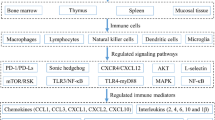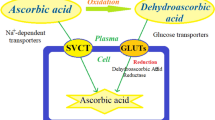Abstract
Background
The flavonoids are a diverse family of chemicals commonly found in fruits and vegetables. Previously, we have shown that the two flavones, chrysin and apigenin could suppress the expression of the high affinity IgE receptor FcεRI in human basophilic KU812 cells. We also demonstrated that dietary apigenin decreased IgE level in C57BL/6N mice sera.
Aim of the study
To evaluate the anti-allergic effect of the two flavones in vivo, we evaluated the effect of the two flavones, chrysin and apigenin, on the immune system in BALB/c mice sensitized with ovalbumin (OVA).
Methods
Mice were fed experimental diets containing either of the flavones for 3 weeks and immunized with OVA. After the experimental feeding period, measurement of Igs concentration in the mice sera was performed using a sandwich ELISA. Cytokines expression in mice sera was assessed using a cytokine array. Furthermore, cytokines mRNA levels in spleen lymphocytes from mice sensitized with OVA were measured by RT-PCR.
Results
The total IgE level in mice fed one of the two flavones were suppressed, whereas levels of IgG, IgM, and IgA were not affected. The production of interleukin (IL)-4, which is known as one of Th2 cytokines and regulates the production of IgE, was down-regulated by the chrysin or the apigenin diet. Moreover, OVA-induced mRNA expression of Th2 cytokines in spleen lymphocytes from mice sensitized with OVA, such as IL-4 and IL-13 were down-regulated by the chrysin or the apigenin diet.
Conclusions
The results suggest that the diet containing one of the two flavones might suppress the up-regulation of serum IgE induced by OVA-immunization through the suppression of Th2-type immune response.



Similar content being viewed by others
References
Avila MA, Velasco JA, Cansado J, Notario V (1994) Quercetin mediates the down-regulation of mutant p53 in the human breast cancer cell line MDA-MB468. Cancer Res 54:2424–2428
Gerritsen ME, Carley WW, Ranges GE, Shen CP, Phan SA, Ligon GF, Perry CA (1995) Flavonoids inhibit cytokine-induced endothelial cell adhesion protein gene expression. Am J Pathol 147:278–292
Yano S, Tachibana H, Yamada K (2005) Flavones suppress the expression of the high-affinity IgE receptor FcεRI in human basophilic KU812 cells. J Agric Food Chem 53:1812–1817
Yano S, Umeda D, Maeda N, Fujimura Y, Yamada K, Tachibana H (2006) Dietary apigenin suppresses IgE and inflammatory cytokines production in C57BL/6N mice. J Agric Food Chem 54:5203–5207
Liang YC, Tsai SH, Tsai DC, Lin-Shiau SY, Lin JK (2001) Suppression of inducible cyclooxygenase and nitric oxide synthase through activation of peroxisome proliferator-activated receptor-γ by flavonoids in mouse macrophages. FEBS Lett 496:2–18
Fujimura Y, Tachibana H, Yamada K (2002) Peroxisome proliferator-activated receptor ligands negatively regulate the expression of the high-affinity IgE receptor FcεRI in human basophilic KU812 cells. Biochem Biophys Res Commun 297:193–201
Miyazaki Y, Tachibana H, Yamada K (2002) Inhibitory effect of peroxisome proliferator-activated receptor-γ ligands on the expression of IgE heavy chain germline transcripts in the human B cell line DND39. Biochem Biophys Res Commun 295:547–552
Reeves PG, Nielsen FH, Fahey GC Jr (1993) AIN-93 purified diets for laboratory rodents: final report of the American Institute of Nutrition ad hoc writing committee on the reformulation of the AIN-76A rodent diet. J Nutr 123:1939–1951
Fujimura Y, Tachibana H, Eto N, Yamada K (2000) Antigen binding of an ovomucoid-specific antibody is affected by a carbohydrate chain located on the light chain variable region. Biosci Biotechnol Biochem 64:2298–2305
Cher DJ, Mosmann TR (1987) Two types of murine helper T cell clone. II. Delayed-type hypersensitivity is mediated by TH1 clones. J Immunol 138:3688–3694
Mosmann TR, Coffman RL (1989) Heterogeneity of cytokine secretion patterns and functions of helper T cells. Adv Immunol 46:111–147
Fiorentino DF, Bond MW, Mosmann TR (1989) Two types of mouse T helper cell. IV. Th2 clones secrete a factor that inhibits cytokine production by Th1 clones. J Exp Med 170:2081–2095
Gieni RS, Yang X, HayGlass KT (1993) Allergen-specific modulation of cytokine synthesis patterns and IgE responses in vivo with chemically modified allergen. J Immunol 150:302–310
Holgate ST (1999) The allergy and asthma. Nature 402:B2–B4
Corry DB, Kheradmand F (1999) Induction and regulation of the IgE response. Nature 402:B18-B23
Kotani M, Matsumoto M, Fujita A, Higa S, Wang W, Suemura M, Kishimoto T, Tanaka T (2000) Persimmon leaf extract and astragalin inhibit development of dermatitis and IgE elevation in NC/Nga mice. J Allergy Clin Immunol 106:159–166
Quelle FW, Shimoda K, Thierfelder W (1995) Cloning of murine Stat6 and human Stat6, Stat proteins that are tyrosine phosphorylated in responses to IL-4 and IL-3 but are not required for mitogenesis. Mol Cell Biol 15:3336–3343
Schindler U, Wu P, Rothe M, Brasseur M, McKnight SL (1995) Components of a Stat recognition code: Evidence for two layers of molecular selectivity. Immunity 2:689–697
Tachibana H, Kubo T, Miyase T, Tanino S, Yoshimoto M, Sano M, Yamamoto-Maeda M, Yamada K (2001) Identification of an inhibitor for interleukin 4-induced ε germline transcription and antigen-specific IgE production in vivo. Biochem Biophys Res Commun 280:53–60
Gangur V, Oppenheim JJ (2000) Are chemokines essential or secondary participants in allergic responses? Ann Allergy Asthma Immunol 84:569–581
Acknowledgments
We thank Perry Seto for proofreading the manuscript. We thank A. Nagayama, N. Maeda, S. Kobayashi, Y. Hiura, T. Funahashi, H. Namisaki, S. Ota, S. Tomiyama, A. Kaji, S. Tsuruda and J. H. Lee for their technical assistance. The first author was supported by a fellowship from the Research Fellowships of the Japan Society for the Promotion of Science for Young Scientists.
Author information
Authors and Affiliations
Corresponding author
Rights and permissions
About this article
Cite this article
Yano, S., Umeda, D., Yamashita, T. et al. Dietary flavones suppresses IgE and Th2 cytokines in OVA-immunized BALB/c mice. Eur J Nutr 46, 257–263 (2007). https://doi.org/10.1007/s00394-007-0658-7
Received:
Accepted:
Published:
Issue Date:
DOI: https://doi.org/10.1007/s00394-007-0658-7




